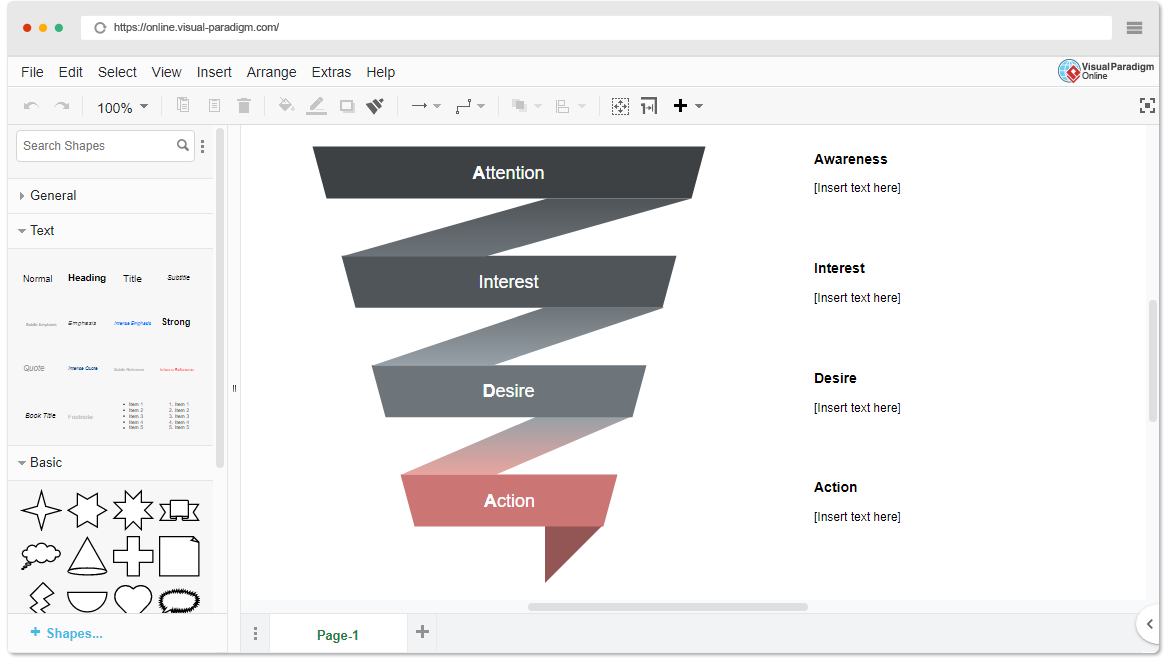Comprehensive Guide to the AIDA Funnel
Introduction
The AIDA model is a fundamental framework in marketing and advertising that helps businesses guide customers through the various stages of their buying journey. AIDA stands for Awareness, Interest, Desire, and Action, which represent the key stages a potential customer goes through before making a purchase decision. The primary purpose of the AIDA model is to assist marketers in crafting effective marketing communications strategies that target each of these stages, ultimately leading to conversions and customer loyalty.

Key Concepts and Elements of the AIDA Model
1. Awareness
Purpose: Creating brand awareness or affiliation with your product or service.
Description: At this stage, the goal is to make potential customers aware of your brand’s existence and what it offers. This is often the first point of contact with your target audience.
Key Elements:
- Advertising: Use various marketing channels to showcase your brand and products.
- Content Marketing: Create content that educates, informs, and entertains your audience.
- Social Media: Utilize social platforms to engage with your audience and build a presence.
2. Interest
Purpose: Generating interest in the benefits of your product or service, and encouraging further research.
Description: Once potential customers are aware of your brand, the next step is to pique their interest. This involves highlighting the unique value propositions and benefits of your offerings.
Key Elements:
- Engaging Content: Provide detailed information about your products or services.
- Customer Testimonials: Share positive experiences from existing customers.
- Email Marketing: Send targeted emails to nurture leads and provide additional information.
3. Desire
Purpose: Creating an emotional connection and moving the consumer from liking to wanting your product.
Description: In this stage, you want to ignite a desire for your product or service. Showcasing how it can meet the customer’s needs and aspirations is crucial.
Key Elements:
- Storytelling: Craft compelling narratives that resonate with your target audience.
- Exclusive Offers: Create special promotions to make the offer more enticing.
- Visual Appeal: Use high-quality visuals to showcase your product’s benefits.
4. Action
Purpose: Encouraging the buyer to interact with your company and take the next step.
Description: The action stage is where you convert interested prospects into customers. It involves getting them to make a specific move, such as making a purchase, signing up, or contacting your sales team.
Key Elements:
- Call to Action (CTA): Clearly instruct potential customers on what to do next.
- Landing Pages: Create dedicated landing pages optimized for conversions.
- Online Forms: Make it easy for customers to provide their information.
5. Retention
Purpose: Building and maintaining an ongoing relationship with customers for long-term value.
Description: While not part of the core AIDA acronym, some marketers add the “Retention” stage to emphasize the importance of customer loyalty and relationship-building.
Key Elements:
- Customer Support: Provide excellent customer service to address issues and questions.
- Email Marketing: Continue engaging with customers through newsletters and updates.
- Cross-Selling and Upselling: Offer complementary products or upgrades.
- Referral Programs: Encourage satisfied customers to refer others.
Learn by Examples using Visual Paradigm Online Templates
Visual Paradigm Online offers a range of templates and tools for creating visual representations of the AIDA model and related marketing strategies. Here’s how you can use pre-made templates in Visual Paradigm Online:
- Access Visual Paradigm Online: If you haven’t already, sign up for an account or log in to Visual Paradigm Online.
- Choose a Template: In the template library, search for “AIDA model” or related keywords. Select a template that suits your needs.
- Edit and Customize: Use the template as a starting point. Add your brand elements, specific content, and data relevant to your marketing campaign. You can modify text, images, and shapes to tailor the template to your requirements.
- Collaborate: Invite team members to collaborate on the project within Visual Paradigm Online. Multiple team members can work on the same diagram simultaneously.
- Export and Share: Once you’ve created your AIDA model representation, export it in various formats (e.g., PDF, image) and share it with your team or stakeholders for feedback and implementation.
Using Visual Paradigm Online’s templates can streamline the process of visualizing and planning your AIDA-based marketing strategy.
Conclusion
The AIDA model is a timeless framework that helps marketers understand and influence the customer journey. By implementing this model and utilizing tools like Visual Paradigm Online, you can create effective marketing communications strategies that guide potential customers from awareness to action, ultimately driving conversions and fostering long-term relationships.

